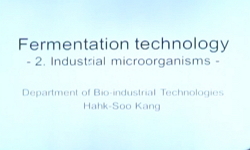Liquid-liquid extraction (LLE) using various solvents was studied for recovery of acetic acid from a synthetic ethanol fermentation broth. The microbial fermentation of sugars presented in hydrolyzate gives rise to acetic acid as a byproduct. In order...
http://chineseinput.net/에서 pinyin(병음)방식으로 중국어를 변환할 수 있습니다.
변환된 중국어를 복사하여 사용하시면 됩니다.
- 中文 을 입력하시려면 zhongwen을 입력하시고 space를누르시면됩니다.
- 北京 을 입력하시려면 beijing을 입력하시고 space를 누르시면 됩니다.


Recovery of Acetic Acid from An Ethanol Fermentation Broth by Liquid-Liquid Extraction (LLE) Using Various Solvents = Recovery of Acetic Acid from An Ethanol Fermentation Broth by Liquid-Liquid Extraction (LLE) Using Various Solvents
한글로보기https://www.riss.kr/link?id=A101573442
-
저자
( Thi Thu Huong Pham ) (공주대학교) ; ( Tae Hyun Kim ) ; ( Byung Hwan Um )
- 발행기관
- 학술지명
- 권호사항
-
발행연도
2015
-
작성언어
-
- 주제어
-
KDC
500
-
등재정보
SCOPUS,KCI등재,ESCI
-
자료형태
학술저널
- 발행기관 URL
-
수록면
695-702(8쪽)
-
KCI 피인용횟수
0
- DOI식별코드
- 제공처
-
0
상세조회 -
0
다운로드
부가정보
다국어 초록 (Multilingual Abstract)
Liquid-liquid extraction (LLE) using various solvents was studied for recovery of acetic acid from a synthetic ethanol fermentation broth. The microbial fermentation of sugars presented in hydrolyzate gives rise to acetic acid as a byproduct. In order to obtain pure ethanol for use as a biofuel, fermentation broth should be subjected to acetic acid removal step and the recovered acetic acid can be put to industrial use. Herein, batch LLE experiments were carried out at 25°C using a synthetic fermentation broth comprising 20.0 g l-1 acetic acid and 5.0 g l-1 ethanol. Ethyl acetate (EtOAc), tri-n-octylphosphine oxide (TOPO), tri-n-octylamine (TOA), and tri-n-alkylphosphine oxide (TAPO) were utilized as solvents, and the extraction potential of each solvent was evaluated by varying the organic phase-to-aqueous phase ratios as 0.2, 0.5, 1.0, 2.0, and 4.0. The highest acetic acid extraction yield was achieved with TAPO; however, the lowest ethanol-to-acetic acid extraction ratio was obtained using TOPO. In a single-stage batch extraction, 97.0 % and 92.4 % of acetic acid could be extracted using TAPO and TOPO when the ratio of organic-to-aqueous phases is 4:1 respectively. A higher solvent-to-feed ratio resulted in an increase in the ethanol-to-acetic acid ratio, which decreased both acetic acid purity and acetic acid extraction yield.
참고문헌 (Reference)
1 엄병환, "혼합 하드우드 칩으로부터 녹액(Green Liqour)선-펄핑추출 공정에 관한 연구" 한국화학공학회 51 (51): 561-567, 2013
2 Radler, F., "Wine microbiology and biotechnology" Harwood Academic Publishers 1983
3 Klosowski, G., "The influence of Raw Material Contamination with Mycotoxins on Alcoholic Fermentation Indicators" 101 : 3147-3152, 2010
4 Ricker, N. L., "Solvent Properties of Organic Bases for Extraction of Acetic Acid from Water" 1 : 36-41, 1979
5 Niitsu, M., "Solvent Extraction Equilibria of acids. VI. The extraction of Several Mono-and Dicarboxylic Acids with Trioctylphosphine Oxide in Hexane" 51 : 705-709, 1978
6 Wardell, J. M., "Solvent Equilibriums for Extraction of Carboxylic Acids from Water" 23 : 144-148, 1978
7 Helsel, R. W., "Removing Carboxylic Acids from Aqueous Wastes" 73 (73): 55-59, 1977
8 Xu, Z. P., "Removal of Acetic Acid from Water by Catalytic Distillation. Part 1. Experimental Studies" 77 : 676-681, 1999
9 Anasthas, H. M., "Removal of Acetic Acid Impurities from Ethyl Acetate by Adsorption on ion Exchange Resins" 36 : 2623-2646, 2001
10 Wisniewski, M., "Recovery of Carboxylic Acids C1-C3 with Organophosphine Oxide Solvating Extractant" 80 : 1425-1430, 2005
1 엄병환, "혼합 하드우드 칩으로부터 녹액(Green Liqour)선-펄핑추출 공정에 관한 연구" 한국화학공학회 51 (51): 561-567, 2013
2 Radler, F., "Wine microbiology and biotechnology" Harwood Academic Publishers 1983
3 Klosowski, G., "The influence of Raw Material Contamination with Mycotoxins on Alcoholic Fermentation Indicators" 101 : 3147-3152, 2010
4 Ricker, N. L., "Solvent Properties of Organic Bases for Extraction of Acetic Acid from Water" 1 : 36-41, 1979
5 Niitsu, M., "Solvent Extraction Equilibria of acids. VI. The extraction of Several Mono-and Dicarboxylic Acids with Trioctylphosphine Oxide in Hexane" 51 : 705-709, 1978
6 Wardell, J. M., "Solvent Equilibriums for Extraction of Carboxylic Acids from Water" 23 : 144-148, 1978
7 Helsel, R. W., "Removing Carboxylic Acids from Aqueous Wastes" 73 (73): 55-59, 1977
8 Xu, Z. P., "Removal of Acetic Acid from Water by Catalytic Distillation. Part 1. Experimental Studies" 77 : 676-681, 1999
9 Anasthas, H. M., "Removal of Acetic Acid Impurities from Ethyl Acetate by Adsorption on ion Exchange Resins" 36 : 2623-2646, 2001
10 Wisniewski, M., "Recovery of Carboxylic Acids C1-C3 with Organophosphine Oxide Solvating Extractant" 80 : 1425-1430, 2005
11 Al-Mudhaf, H. F., "Partition Data of Acetic Acid Between Aqueous NaCl Solutions and Trioctylphosphine Oxide in Cyclohexane Diluents" 27 : 41-50, 2002
12 Wiencek, J. M., "Microemulsion Liquid Membranes. 1 Application to Acetic Acid Removal from Water" 27 : 1211-1228, 1992
13 Sabolova, E., "Liquid-liquid Equilibria of Butyric Acid in Water+solvent Systems with Trioctylamine as Extractant" 46 : 735-745, 2001
14 Walton, S., "Inhibition Effects on Fermentation of Hardwood Extracted Hemicelluloses by Acetic Acid and Sodium" 101 : 1935-1940, 2010
15 Juang, R. S., "Extraction of Acetate from Simulated Waste Solutions in Chloromycetin Production" 17 : 225-233, 1999
16 Reisinger, H., "Extraction and Sorption of Acetic Acid at pH Above pKa to form Calcium Magnesium Acetate" 34 : 845-852, 1995
17 Hano, T., "Extraction Equilibria of Organic Acids with tri-n-octylphosphineoxide" 23 : 260-264, 1990
18 Senol, A., "Extraction Equilibria of Formic, Levulinic, and Acetic Acids Using (alamine 336/diluent) and Conversional Solvent Systems: Modeling Consideration" 32 : 717-731, 1999
19 Rodríguez-López, J., "Extracting Value-added Products Before Pulping: Hemicellulosic Ethanol from Eucalyptus Globulus Wood" 66 : 591-599, 2012
20 Delfini, C., "Effects of the Grape Must Lees and Insoluble Materials on the Alcoholic Fermentation Rate and on the Production of Acetic Acid, Pyruvic Acid, and Acetaldehyde" 44 (44): 86-92, 1993
21 Shimazu, Y., "Effects of Yeast Strains and Environmental Conditions on Formation of Organic Acid in Must During Fermentation" 59 (59): 27-32, 1981
22 Galanakis, C. M., "Effect of Pressure and Temperature on Alcoholic Fermentation by Saccharomyces Cerevisiae Immobilized on γ-alumina Pellets" 114 : 492-498, 2012
23 Oliva-Neto, P., "Effect of 3,4,4’-trichlorocarbanilide on Growth of Lactic Acid Bacteria Contaminants in Alcoholic Fermentation" 63 : 17-21, 1998
24 Pawelzik, P., "Critical Aspects in the Life Cycle Assessment (LCA) of Bio-based Materials - Reviewing Methodologies and Deriving Recommendations" 73 : 211-228, 2013
25 van Heiningen, A., "Converting a Kraft Pulp Mill Into an Integrated Forest Biorefinery" 107 (107): 38-43, 2006
26 Um, B. H., "Conditioning Hardwood-derived Pre-pulping Extracts for Use in Fermentation Through Removal and Recovery of Acetic Acid Using Trioctylphosphine Oxide (TOPO)" 65 : 51-58, 2011
27 Cogan, T. M., "Co-metabolism of Citrate and Glucose by Leuconostoc spp.: Effects on Growth, Substrate, and Products" 63 : 551-558, 1987
28 King, C. J., "Amine-based System for Carboxylic Acid Recovery" 5 : 285-291, 1992
29 Drysdale, G. S., "Acetic Acid Bacteria in Winemaking: A Review" 39 (39): 143-153, 1988
30 Byung-Hwan Um, "A CFD model for predicting the flow patterns of viscous fluids in a bioreactor under various operating condition" 한국화학공학회 25 (25): 1094-1102, 2008
동일학술지(권/호) 다른 논문
-
- 한국화학공학회
- 김기섭 ( Ki Sub Kim )
- 2015
- SCOPUS,KCI등재,ESCI
-
새로운 가교제를 적용한 촉매를 이용한 글루코스 센서의 성능향상 연구
- 한국화학공학회
- 정용진 ( Yong Jin Chung )
- 2015
- SCOPUS,KCI등재,ESCI
-
폴리올과 붕산의 착화합물 형성원리를 이용한 수용액 중의 보론 제거에관한 라만 분광학 연구
- 한국화학공학회
- 엄기헌 ( Ki Heon Eom )
- 2015
- SCOPUS,KCI등재,ESCI
-
Electrochemical Ionic Mass Transfer Correlation in Fluid-Saturated Porous Layer
- 한국화학공학회
- ( Eun Su Cho )
- 2015
- SCOPUS,KCI등재,ESCI
분석정보
인용정보 인용지수 설명보기
학술지 이력
| 연월일 | 이력구분 | 이력상세 | 등재구분 |
|---|---|---|---|
| 2023 | 평가예정 | 해외DB학술지평가 신청대상 (해외등재 학술지 평가) | |
| 2020-01-01 | 평가 | 등재학술지 유지 (해외등재 학술지 평가) |  |
| 2013-01-01 | 평가 | 등재 1차 FAIL (등재유지) |  |
| 2010-12-02 | 학술지명변경 | 한글명 : 화학공학 -> Korean Chemical Engineering Research(HWAHAK KONGHAK) |  |
| 2010-01-01 | 평가 | 등재학술지 유지 (등재유지) |  |
| 2009-08-25 | 학술지명변경 | 외국어명 : Korean Chem. Eng. Res. -> Korean Chemical Engineering Research |  |
| 2008-01-01 | 평가 | 등재학술지 유지 (등재유지) |  |
| 2007-09-27 | 학회명변경 | 영문명 : The Korean Institute Of Chemical Engineers -> The Korean Institute of Chemical Engineers |  |
| 2006-01-01 | 평가 | 등재학술지 유지 (등재유지) |  |
| 2004-01-01 | 평가 | 등재학술지 유지 (등재유지) |  |
| 2001-07-01 | 평가 | 등재학술지 선정 (등재후보2차) |  |
| 1999-01-01 | 평가 | 등재후보학술지 선정 (신규평가) |  |
학술지 인용정보
| 기준연도 | WOS-KCI 통합IF(2년) | KCIF(2년) | KCIF(3년) |
|---|---|---|---|
| 2016 | 0.43 | 0.43 | 0.4 |
| KCIF(4년) | KCIF(5년) | 중심성지수(3년) | 즉시성지수 |
| 0.37 | 0.35 | 0.496 | 0.11 |




 ScienceON
ScienceON KISS
KISS



